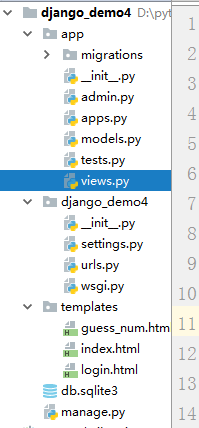
views.py
from django.shortcuts import render
from django.http import HttpResponse
import random
# Create your views here.
numbers = random.randint(1, 101)
class People(object):
def __init__(self, name, age, phone):
self.name = name
self.age = age
self.phone = phone
def index(request):
print(request)
people = People('李四', 25, 1111)
data = {
'name': '张三',
'age': 22,
'numbers': [x for x in range(0, 30) if x % 2 == 0],
'dictData': {'city': '郑州', 'weather': '晴天'},
'people': people
}
return render(request, 'index.html', data)
def login(request):
print(request)
# 判断是get 请求 还是post 请求
if request.method == 'GET':
return render(request, 'login.html')
elif request.method == 'POST':
#
#
ID = request.POST.get('id', default='')
pwd = request.POST.get('pwd', default='')
if ID == '123456789' and pwd == '123456':
return HttpResponse('登录成功')
else:
return render(request, 'login.html', {'error': '密码错误'})
# 定义主页的视图函数
def guess_num(request):
result = ''
# 判断当前请求的 是get /post
# 设置全局变量
global numbers
if request.method == 'POST':
# 从post 请求中提取传递过来的参数
gus_num = request.POST.get('gus_num', default='0')
if gus_num == '':
result = '请重新输入,数字不能为空'
else:
if int(gus_num) < numbers:
result = '猜小了'
elif int(gus_num) > numbers:
result = '猜大了'
else:
result = '猜对了,答案已重置,请继续'
numbers = random.randint(0,101)
names = ['小红', '小明', '小李', '小王', '小花']
data = {
'name': random.choice(names),
'age': random.randint(18, 23),
# 返回的是一个列表,startswith () 是以什么开头的
'names': [name for name in names if name.startswith('小')],
'phone': 13213,
'result': result
}
# data 就是箱模板传递参数
return render(request, 'guess_num.html', data)
settings.py
"""
Django settings for django_demo4 project.
Generated by 'django-admin startproject' using Django 1.11.5.
For more information on this file, see
https://docs.djangoproject.com/en/1.11/topics/settings/
For the full list of settings and their values, see
https://docs.djangoproject.com/en/1.11/ref/settings/
"""
import os
# Build paths inside the project like this: os.path.join(BASE_DIR, ...)
BASE_DIR = os.path.dirname(os.path.dirname(os.path.abspath(__file__)))
# Quick-start development settings - unsuitable for production
# See https://docs.djangoproject.com/en/1.11/howto/deployment/checklist/
# SECURITY WARNING: keep the secret key used in production secret!
SECRET_KEY = 'l&nmv@o_n_g3#k!0lf^0y#3qzb$j7-9hushlmdoup*erbnk1=c'
# SECURITY WARNING: don't run with debug turned on in production!
DEBUG = True
ALLOWED_HOSTS = []
# Application definition
INSTALLED_APPS = [
'django.contrib.admin',
'django.contrib.auth',
'django.contrib.contenttypes',
'django.contrib.sessions',
'django.contrib.messages',
'django.contrib.staticfiles',
'app'
]
MIDDLEWARE = [
'django.middleware.security.SecurityMiddleware',
'django.contrib.sessions.middleware.SessionMiddleware',
'django.middleware.common.CommonMiddleware',
'django.middleware.csrf.CsrfViewMiddleware',
'django.contrib.auth.middleware.AuthenticationMiddleware',
'django.contrib.messages.middleware.MessageMiddleware',
'django.middleware.clickjacking.XFrameOptionsMiddleware',
]
ROOT_URLCONF = 'django_demo4.urls'
TEMPLATES = [
{
'BACKEND': 'django.template.backends.django.DjangoTemplates',
'DIRS': [os.path.join(BASE_DIR, 'templates')],
'APP_DIRS': True,
'OPTIONS': {
'context_processors': [
'django.template.context_processors.debug',
'django.template.context_processors.request',
'django.contrib.auth.context_processors.auth',
'django.contrib.messages.context_processors.messages',
],
},
},
]
WSGI_APPLICATION = 'django_demo4.wsgi.application'
# Database
# https://docs.djangoproject.com/en/1.11/ref/settings/#databases
DATABASES = {
'default': {
'ENGINE': 'django.db.backends.sqlite3',
'NAME': os.path.join(BASE_DIR, 'db.sqlite3'),
}
}
# Password validation
# https://docs.djangoproject.com/en/1.11/ref/settings/#auth-password-validators
AUTH_PASSWORD_VALIDATORS = [
{
'NAME': 'django.contrib.auth.password_validation.UserAttributeSimilarityValidator',
},
{
'NAME': 'django.contrib.auth.password_validation.MinimumLengthValidator',
},
{
'NAME': 'django.contrib.auth.password_validation.CommonPasswordValidator',
},
{
'NAME': 'django.contrib.auth.password_validation.NumericPasswordValidator',
},
]
# Internationalization
# https://docs.djangoproject.com/en/1.11/topics/i18n/
LANGUAGE_CODE = 'en-us'
TIME_ZONE = 'UTC'
USE_I18N = True
USE_L10N = True
USE_TZ = True
# Static files (CSS, JavaScript, Images)
# https://docs.djangoproject.com/en/1.11/howto/static-files/
STATIC_URL = '/static/'
urls.py
"""django_demo4 URL Configuration
The `urlpatterns` list routes URLs to views. For more information please see:
https://docs.djangoproject.com/en/1.11/topics/http/urls/
Examples:
Function views
1. Add an import: from my_app import views
2. Add a URL to urlpatterns: url(r'^$', views.home, name='home')
Class-based views
1. Add an import: from other_app.views import Home
2. Add a URL to urlpatterns: url(r'^$', Home.as_view(), name='home')
Including another URLconf
1. Import the include() function: from django.conf.urls import url, include
2. Add a URL to urlpatterns: url(r'^blog/', include('blog.urls'))
"""
from django.conf.urls import url
from django.contrib import admin
from app import views
urlpatterns = [
url(r'^index',views.index),
url(r'^guess',views.guess_num),
url(r'^login',views.login),
url(r'^admin/', admin.site.urls),
]
guess_num.html
<!DOCTYPE html>
<html lang="en">
<head>
<meta charset="UTF-8">
<title>猜数字首页</title>
<style>
nav{
text-align: center;
color: mediumaquamarine;
font-family: 楷体;
}
main{
position: relative;
width: 100%;
}
main>div{
width: 600px;
margin:0 auto;
text-align: center;
}
</style>
</head>
<body>
<nav>
{# {{ 取传递过来的变量的值 }} #}
<h3>欢迎{{ name }}来猜数字游戏</h3>
<h3>年龄: {{ age }}</h3>
<h3>电话: {{ phone }}</h3>
{# 模板中的for循环 #}
{% for name in names %}
{# 取出列表中的每一个元素 #}
<h3>{{ name }}</h3>
{# endfor 表示for 循环结束 #}
{% endfor %}
</nav>
<main>
<div>
{# action 表单提交的路由地址 method 指定提交的方式 默认get #}
<form action="/guess/" method="post">
{# csrf_token 提交token 验证 #}
{% csrf_token %}
{# placeholder 占位字符 name 表单数据对应的key#}
<input name="gus_num" type="text" placeholder="请输入你猜的数字"><br>
<button type="submit">提交</button>
</form>
<h3>{{ result }}</h3>
</div>
</main>
</body>
</html>index.html
<!DOCTYPE html>
<html lang="en">
<head>
<meta charset="UTF-8">
<title>模板参数传递</title>
</head>
<body>
<h1>{{ name }}</h1>
<h1>{{ age }}</h1>
{# for 循环遍历列表 ,取出每一个值 #}
<ul>
{# 每执行一次for循环,都会新建一个li标签 #}
{% for num in numbers %}
{# 每次for 循环,都会新建一个li标签 #}
{# forloop.counter(从1开始) counter0(从0开始) 记录循环的次数 .first判断是否为列表的第一个元素#}
{# if 可以判断某些条件是否成立 #}
{% if forloop.first %}
<li>这是第一个元素</li>
{% elif forloop.last %}
<li>这是最后一个元素</li>
{% else %}
<li>{{ num }}</li>
{% endif %}
<li>{{ forloop.counter}}</li>
{% endfor %}
</ul>
{#使用if 判断某个参数是否存在 #}
{% if dictData %}
<h1>dictData这个参数</h1>
<h3>{{ dictData.city }}</h3>
<h3>{{ dictData.weather }}</h3>
{% else %}
<h1>没有dictData这个参数</h1>
{% endif %}
{# 穿过来的是自定义对象,直接通过,属性获取属性值 #}
<h1> {{poeple.name }}</h1>
<h1> {{people.age }}</h1>
<h1> {{people.phone }}</h1>
{# 填写要访问的路由 #}
<a href="/login/">点击登录</a>
</body>
</html>login.html
<!DOCTYPE html>
<html lang="en">
<head>
<meta charset="UTF-8">
<title>银行卡登录页面</title>
</head>
<body>
<div>填写完点击登录</div>
<form action="/login/" method="post">
{# csrf_token验证 #}
{% csrf_token %}
<input name="id" type="text" placeholder="请输入银行卡号">
<input name="pwd" type="password" placeholder="请输入取款密码">
<button type="submit">点击登录 </button>
{% if error %}
<h1>{{ error }}</h1>
{% endif %}
</form>
</body>
</html>